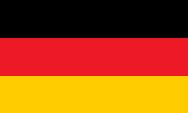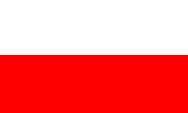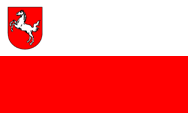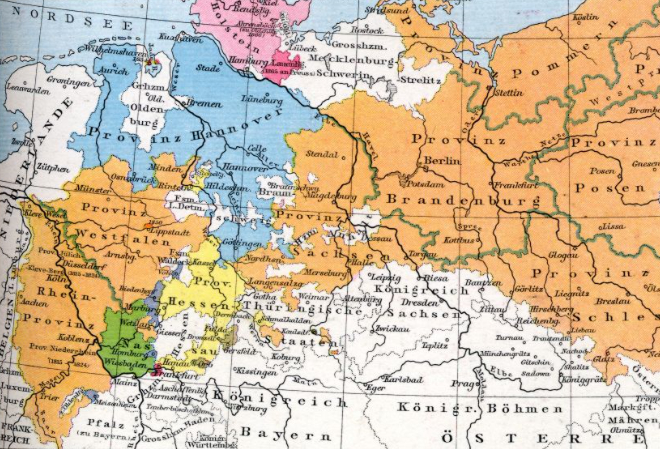mobile View, to the German Version tap the flag


- Westphalia (better: Westfalia)
- former Prussian province
- dissolved in 1946
• Flags
• Meaning/Origin of the Flag
• Coat of Arms
• Meaning/Origin of the Coat of Arms
• Map
• Numbers and Facts
• History
• Origin of the Country's Name

Colours of the country,
ratio = 3:5




Official flag (doubtful),
ratio = 3:5




From 1875, the provinces of Prussia could largely operate in self-governing. There was a provincial parliament and a provincial government (Provincial Committee). Each province had its own colors (Landesfarben), which were also used as flag, and they had also their own coat of arms. If the provincial governments put for official purposes (official flag) their coats of arms on a flag with the provincial colors is not handed down beyond doubt and not for all provinces. The colours of the flag of the province Westfalia, white and red, have their historical roots in the coat of arms of Westfalia: white horse on red ground.
Another incident for the flag was the seizure of power by the National Socialists in the German Empire in 1933. All official non-swastika flags, that refered to federalism, regional references or the old German Empire were abolished between 1933 and 1935. For the National Socialists, the federal structure of the German Empire, its historically grown countries, was considered as outdated, as relics of a past to be overcome. In this sense, several laws were enacted, on 31st of March in 1933 the 'Provisional Law for the phasing of the countries with the Empire', on 7th of April 1933 the 'Second Law for the phasing of the countries with the Empire' and finally, on 30th January in 1934 the 'Law on the rebuilding of the empire'. Thus, the federal structure of the German Empire was replaced by the gau-structure of the NSDAP, the countries became meaningless. From now on, offices and authorities had to use the swastika flag as official flag, until September 15th in 1935, when by the flag-law was legislated a new created official flag for all the offices and authorities of the empire. The prime ministers of the countries, which latest in 1933 all came from the NSDAP – now mostly called Reichsstatthalter (maybe translated as 'governor') – however remained in office until 1945. This was then also applied on the provinces of the state of Prussia. Their sovereign duties were taken over by the Gau structure of the NSDAP, which sometimes coincided with the borders of the provinces and sometimes they were new created. The respective provincial flags disappeared. The corresponding country colours continued, with restrictions, but definitly not in the form of flags. They were used, for example, occasionally on uniforms of the SA or in some ranks of the Hitler Youth in the breast cord.
After the war, the administration within the German Empire was rebuilt, but locally, following the structure of the countries. These have been partly old countries, and some new countries were created. Sometimes they bethought the old country colours and reactivated them – or they created new ones – for limited sovereign duties, which were under the control of the Allies. With the founding of the FRG and the GDR, an internal country-structure was finalised for both entities and corresponding official flags were introduced for these countries.
Source: Volker Preuß,
Jürgen Kaltschmitt,
Uniform-Fibel


to 1946,
Coat of arms of the Province of Westphalia,
Source, by: Deutsche Wappen Rolle

The white horse is the "Saxons Ross". It has its roots in the Tribal-Duchy of Saxony and was later adoped from the Welfen-Dynasty. Their symbol was actually a golden lion on red ground. Westphalia belonged until 1180 to the zone of influence of the Welfen-Dynasty. In this way became it the heraldic animal of the Kingdom of Hannover (since 1866 Prussian Province of Hannover), of the Prussian Province of Westphalia and since 1922 of the Country of Brunswick. This tradition is continued in the FRG at those federal countries to which formerly Welfian territories belong. In this way they have until today the white horse in their coats of arms: Lower Saxony and North-Rhine Westfalia. In old reproductions of coats of arms (at least until 1935) the Saxons Ross held its tail always upward. With the new-creation of the State of Hannover was that tradition broken after the Second World War, because the Saxons Ross held on its flag its tail downwards. That was continued in the Country of Lower Saxony – the successor of the State of Hannover. Because of that the Saxons Ross is called in Westphalia (wehre it holds the tail still upward) "Westphalia Horse", in contrast to the "Lower Saxony Horse".
Source: Wikipedia (D),
Deutsche Wappen Rolle,
Volker Preuß


Source: Professor G. Droysens Allgemeiner Historischer Handatlas, 1886
The historical map from 1866 shows the Province of Westphalia in the west.

Area: 7.805 square miles
Inhabitants: 4.811.000 (1925)
Density of Population: 615 inh./sq.mi.
Capital: Muenster
Source: www.gonschior.de

since the 8th century · one of the three Saxon tribal provinces
1180 · creation of the Duchy of Westphalia by emperor Friedrich I. Barbarossa
1180–1793 · to the later Electorate and Archbishopric of Colonia
1807–1813 · Kingdom of Westphalia
1815 · creation of the Prussian Province of Westphalia out of
- the ancient Westphalia
- the County of Sayn-Wittgenstein
- the Abbey of Essen
1945 · occupation by allied squads, British zone of occupation
1946 · creation of the Country of North Rhine-Westphalia by unification of the Province of Westphalia with the northern part of the Rhine Province and the Country of Lippe-Detmold
Source: Atlas zur Geschichte,
Wikipedia (D),
Discovery '97

The landscape-name "Falen" is of Germanic origin. comes from the Old-High German word "falaho", which means "lowland people". This was even the name for the plain that was divided by the river Weser in Eastern Falen and Western Falen. After the defeat of the Saxons against Charlemagne in 785, Saxony was annexed to the Franconian Empire and became divided into three tribal provinces. "Westfalia", "Eastfalia" and in between "Angaria (Engern)". They became later own duchies. The by Napoléon in 1807 created Kingdom of Westphalia (French: Royaume de Westphalie) has nothing to do with it. Obviously, only the name was borrowed. To avoid confusion with the real historic "Westphalia" (in German written: Westfalen), Napoléons creation is in germany now generally to write as "Westfalia" (German: Westfalen).
Source: Wikipedia (D),
Volker Preuß,
Handbuch der geographischen Namen







Kindly supported by: A. Kortmann (D)
![]()








